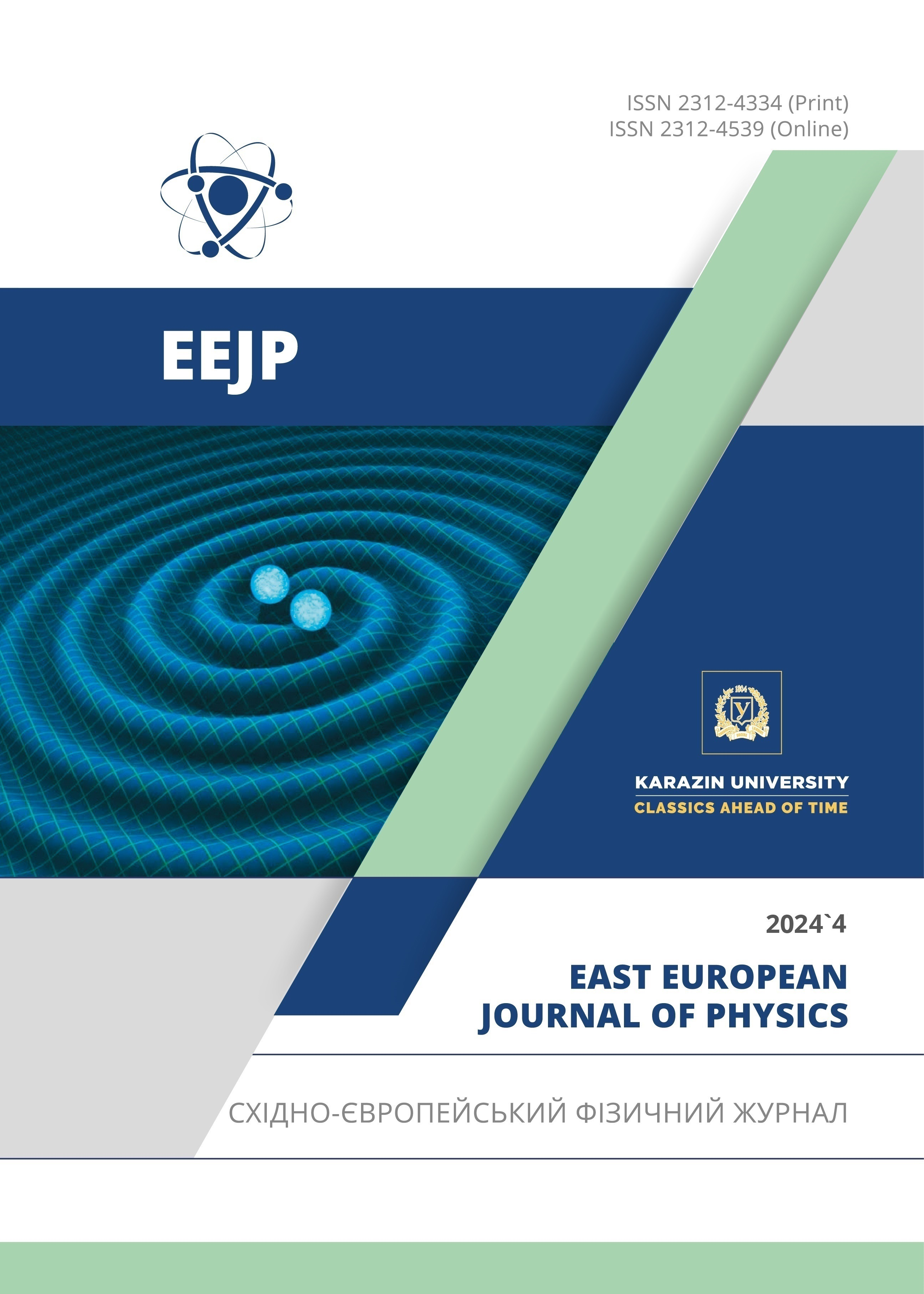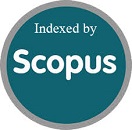Базові дослідження: оптоелектронні властивості сонячних елементів на основі сплаву вюрцита InGaN в межах модифікованого обмінного потенціалу Беке-Джонсона (mBJ)
Анотація
Чисельне моделювання на основі розрахунків повної лінеаризованої розширеної плоскої хвилі (FP-LAPW) реалізовано в коді WIEN2K для вивчення фундаментальних структурних і оптоелектронних властивостей потрійної структури сплаву Wurtzite InxGa1-xN (x = 0,125, 0,375, 0,625 і 0,875) узгоджено на підкладці GaN за допомогою 16-атомної суперкомірки. Узагальнене градієнтне наближення Ву та Коена, стандартний підхід локальної щільності та Тран-Блаха модифікований потенціал Бекке–Джонсона, були застосовані для покращення зонної структури та оптичних властивостей відповідних сполук. Коли це можливо, ми порівнюємо отримані результати за допомогою експериментів і обчислень, виконаних за різними обчислювальними схемами. У цих сплавах основні точки в оптичних спектрах відображають перехід електронів із валентної зони до незаповнених станів у зоні провідності. Результати свідчать про те, що потенціал Беке Джонсона буде багатообіцяючим потенціалом для розробки заборонених зон сполук III-V, які показали, що ці матеріали мають вирішальні коефіцієнти поглинання, які призводять до застосування для компонентів оптоелектроніки, особливо сонячних елементів.
Завантаження
Посилання
Liu, F., Wang, T., Gao, X., Yang, H., Zhang, Z., Guo, Y., ... & Wang, X. “Determination of the preferred epitaxy for III-nitride semiconductors on wet-transferred graphene,” Science Advances, 9(31), eadf8484 (2023). https://doi.org/10.1016/j.commatsci.2024.113264
G. Rehman, et al., “Electronic Band Structures of the Highly Desirable III-V Semiconductors: TB-mBJ DFT Studies,” J. Electron. Mater. 45, 3314 (2016). https://doi.org/10.1007/s11664-016-4492-7
Benbedra, A., Meskine, S., Boukortt, A., & Abbassa, H. “Polarization Properties of Wurtzite III-Nitride Alloys Using the Hexagonal Reference Structure,” ECS Journal of Solid-State Science and Technology, 12(10), 103008 (2023). https://doi.org/10.1149/2162-8777/acfe9a
B.-T. Liou, S.-H. Yen, and Y.-K. Kuo, “Vegard’s law deviation in band gaps and bowing parameters of the wurtzite III-nitride ternary alloys,” in: Semiconductor Lasers and Applications II, vol. 5628, edited by J.Q. Yao, Y.J. Chen, and S. Lee, (International Society for Optics and Photonics, SPIE, 2005), pp. 296–305, https://doi.org/10.1117/12.575300
C.J. Praharaj, Group III-Nitride Semiconductor Optoelectronics, (John Wiley & Sons, 2023).
M. Aslan, et al., “Structural and electronic properties of InNxP1−x alloy in full range (0 ≤ x ≤ 1),” Philosophical Magazine, 96, 991 (2016). https://doi.org/10.1080/14786435.2016.1149248
Chouchen, B., Ducroquet, F., Nasr, S., Alzahrani, A. Y., Hajjiah, A. T., & Gazzah, M. H. InxGa1-xN/GaN double heterojunction solar cell optimization for high temperature operation. Solar Energy Materials and Solar Cells, 234, 111446 (2022). https://doi.org/10.1016/j.solmat.2021.111446
Giorgi, G., Amato, M., Ossicini, S., Cartoixa, X., Canadell, E., & Rurali, R. “Doping of III–V arsenide and phosphide wurtzite semiconductors,” The Journal of Physical Chemistry C, 124(49), 27203-27212 (2020). https://dx.doi.org/10.1021/acs.jpcc.0c09391
Imran, A., Sulaman, M., Yousaf, M., Anwar, M. A., Qasim, M., Dastgeer, G., ... & Wang, X. “Growth of High Mobility InN Film on Ga‐Polar GaN Substrate by Molecular Beam Epitaxy for Optoelectronic Device Applications,” Advanced Materials Interfaces, 10(20), 2200105 (2023). https://doi.org/10.1002/admi.202200105
Reilly, C. E., Keller, S., Nakamura, S., & DenBaars, S. P. “InN quantum dots by metalorganic chemical vapor deposition for optoelectronic applications,” Frontiers in Materials, 8, 647936 (2021). https://doi.org/10.3389/fmats.2021.647936
H. Abboudi, H. EL Ghazi, R. En-nadir, M.A. Basyooni-M. Kabatas, A. Jorio, I. Zorkani, “Efficiency of InN/InGaN/GaN Intermediate-Band Solar Cell under the Effects of Hydrostatic Pressure, In-Compositions, Built-in-Electric Field, Confinement, and Thickness,” Nanomaterials, 14, 104 (2024). https://doi.org/10.3390/nano14010104
R. Belghouthi, A. Rached, M. Aillerie, et al., “N-Face Semi-Bulk Absorber Boosts Conversion Efficiency of InGaN Solar Cell,” J. Electron. Mater. 52, 7566–7575 (2023). https://doi.org/10.1007/s11664-023-10662-w
A. Bouadi, H. Naim, A. Djelloul, Y. Benkrima, R. Fares, “Enhancing the efficiency of the gallium indium nitride (InGaN) solar cell by optimizing the effective parameters,” Chalcogenide Letters, 19(9), 611-619 (2022). https://doi.org/10.15251/CL.2022.199.611
Benahmedi, L., Besbes, A., & Djelti, R. “Structural, magnetic, elastic, and thermoelectric properties of Ba2InOsO6 double perovskite in the cubic phase: A DFT+ U study with spin-orbit-coupling,” Journal of Magnetism and Magnetic Materials, 611, 172629. (2024). https://doi.org/10.1016/j.jmmm.2024.172629
Lakhdar, B., Anissa, B., Radouan, D., Al Bouzieh, N., & Amrane, N. “Structural, electronic, elastic, optical and thermoelectric properties of ASiCl3 (A= Li, Rb and Cs) chloroperovskites: a DFT study,” Optical and Quantum Electronics, 56(3), 313 (2024). https://doi.org/10.1007/s11082-023-06045-4
L.C. de Carvalho, et al., “Ab initio calculation of optical properties with excitonic effects in wurtzite InxGa1−xN and InxAl1−xN alloys,” Physical Review B, 87, 195211 (2013). https://doi.org/10.1103/PhysRevB. 87.195211
S. A. Hashemizadeh, and S. V. Mohammadi, “First-Principles Investigation of Density of States and Electron Density in Wurtzite In0.5Ga0.5N Alloys with GGA-PBEsol Method,” Journal of Nanostructures, 6, 273 (2016) https://doi.org/10.22052/jns.2016.40758
W.-W. Lin and Y.-K. Kuo, “Band structures and bandgap bowing parameters of wurtzite and zincblende III-nitrides,” in: Semiconductor Lasers and Applications, vol. 4913, edited by Y. Luo and Y. Nakano, (International Society for Optics and Photonics, SPIE, 2002), pp. 236-247. https://doi.org/10.1117/12.482239
N. N. Anua, et al., “DFT Investigations of the Optical Properties of Gallium Arsenide”, in: Advanced Materials Research, vol. 895, (Trans. Tech. Publications Ltd, 2014), pp. 429–438, https://doi.org/10.4028/www.scientific.net/AMR.895.429
K. Schwarz, and P. Blaha, “Solid state calculations using WIEN2k,” Computational Materials Science, 28, 259 (2003). https://doi.org/10.1016/S0927-0256(03)00112-5
B. Amin, and I. Ahmad, “Theoretical investigation of half metallicity in Fe/Co/Ni doped ZnSe material systems,” Journal of Applied Physics, 106, 093710 (2009). https://doi.org/10.1063/1.3256186
P. Hohenberg, and W. Kohn, “Inhomogeneous Electron Gas, Physical Review, 136, B864 (1964). https://doi.org/10.1103/PhysRev.136.B864
W. Kohn, and L. J. Sham, “Self-Consistent Equations Including Exchange and Correlation Effects,” Physical Review, 140, A1133 (1965). https://doi.org/10.1103/PhysRev.140.A1133
M. Dadsetani, B. Kianisadr, and H. Nejatipour, “First Principles Investigation of the Optical Properties of BNxP1−x (0 ≤ x ≤ 1) Boron Ternary Alloys,” J. Electron. Mater. 44, 2699-2711 (2015). https://doi.org/10.1007/s11664-015-3691-y
B.-T. Liou, and C.-W. Liu, “Electronic and Structural Properties of zincblende AlxIn1−xN,” Optics Communications, 274, 361 (2007). https://doi.org/10.1016/j.optcom.2007.02.040
B. Amin, et al., “Ab initio study of the bandgap engineering of Al1−xGaxN for optoelectronic applications,” Journal of Applied Physics, 109, 023109 (2011). https://doi.org/10.1063/1.3531996
A. Benzina, et al., “First-principles calculation of structural, optoelectronic properties of the cubic AlxGayIn1−x−yN quaternary alloys matching on AlN substrate, within modified Becke–Johnson (mBJ) exchange potential,” Optik, 127, 11577 (2016). https://doi.org/10.1016/j.ijleo.2016.09.014
D. Koller, F. Tran, and P. Blaha, “Merits and limits of the modified Becke-Johnson exchange potential,” Physical Review B, 83, 195134 (2011). https://doi.org/10.1103/PhysRevB.83.195134
M. B. Asfia, and M. A. Rashid, “First-Principles Study of Half Metallic Ferromagnetic and Optical Properties of Nb Doped Cubic ZnS using TB-mBJ Approximation,” Dhaka University Journal of Science, 69, 194–201 (2022). https://doi.org/10.3329/dujs.v69i3.60030
S. Berri, “Theoretical analysis of the structural, electronic, optical and thermodynamic properties of trigonal and hexagonal Cs3Sb2I9 compound,” The European Physical Journal B, 93, 1-12 (2020). https://doi.org/10.1140/epjb/e2020-10143-1
V. Tyuterev, and N. Vast, “Murnaghan’s equation of state for the electronic ground state energy,” Computational Materials Science, 38, 350 (2006). https://doi.org/10.1016/j. commatsci.2005.08.012
R. Nunez-Gonzalez, et al., “First-principles calculation of the band gap of AlxGa1−xN and InxGa1−xN,” Revista Mexicana de fısica, 54, 111 (2008).
S. Stepanov, et al., “Influence of Poisson’s ratio uncertainty on calculations of the bowing parameter for strained InGaN layers,” MRS Internet Journal of Nitride Semiconductor Research, 6, e6 (2001). https://doi.org/10.1557/S1092578300000181
A. I. Duff, L. Lymperakis, and J. Neugebauer, “Understanding and controlling indium incorporation and surface segregation on InxGa1−xN surfaces: An ab initio approach,” Physical Review B, 89, 085307 (2014). https://doi.org/10.1103/PhysRevB.89.085307
P. Rinke, et al., “Consistent set of band parameters for the group-III nitrides AlN, GaN, and InN,” Physical Review B, 77, 075202 (2008). https://doi.org/10.1103/PhysRevB.77.075202
A. Belabbes, et al., “Cubic inclusions in hexagonal AlN, GaN, and InN: Electronic states,” Physical Review B, 84, 125108 (2011). https://doi.org/10.1103/PhysRevB.84.125108
S.-H. Wei, et al., “Breakdown of the band-gap-common-cation rule: The origin of the small band gap of InN,” Physical Review B, 67, 165209 (2003). https://doi.org/10.1103/PhysRevB.67.165209
Tian, Z., Zhang, P., Sun, W., Yan, B., & Sun, Z. “Vegard’s law deviating Ti2 (SnxAl1− x) C solid solution with enhanced properties,” Journal of Advanced Ceramics, 12(8), 1655-1669 (2023). http://dx.doi.org/10.26599/JAC.2023.9220779
E. Sakalauskas, et al., “Dielectric function and bowing parameters of InGaN alloys,” Physica Status Solidi (b), 249, 485 (2012). https://doi.org/10.1002/pssb.201100334
Waack, J. M., Schäfer, N. A., Czerner, M., & Heiliger, C. “Structural, elastic, and electronic properties of cubic zinc-blende InxGa1−xN alloys,” Physical Review B, 110(19), 195201 (2024). https://doi.org/10.1103/PhysRevB.110.195201
M. O’Donnell, E.T. Jaynes, and J.G. Miller, “Kramers–Kronig relationship between ultrasonic attenuation and phase velocity,” The Journal of the Acoustical Society of America, 69, 696 (1981). https://doi.org/10.1121/1.385566
Z.-Y. Jiao, S.-H. Ma, and Y.-L. Guo, “Simulation of optical function for phosphide crystals following the DFT band structure calculations,” Computational and Theoretical Chemistry, 970, 79 (2011). https://doi.org/10.1016/j.comptc.2011.05.030
Resendiz-Hernandez, G., Leal-Perez, J. E., Herrera-Basurto, R., Mercader-Trejo, F. E., Auciello, O., & Hurtado-Macias, A. “Structural properties, bandgap, and complex dielectric function in Bi2Te3 thermoelectric by valence electron energy loss spectroscopy (VEELS) analysis,” Journal of Alloys and Compounds, 965, 171420 (2023). https://doi.org/10.1016/j.jallcom.2023.171420
R. Ali, et al., “The structural, electronic and optical response of IIA–VIA compounds through the modified Becke–Johnson potential,” Physica B: Condensed Matter, 410, 93 (2013). https://doi.org/10.1016/j.physb.2012.09.050
G. Murtaza, et al., “First principle study of cubic perovskites: AgTF3 (T=Mg, Zn),” Physica B: Condensed Matter, 406, 4584 (2011). https://doi.org/10.1016/j.physb.2011.09.026
A. Khettou, I. Zeydi, M. Chellali, M.B. Arbia, Mansouri, S., Helal, H., & Maaref, H. “Simulation and optimization of InGaN Schottky solar cells to enhance the interface quality,” Superlattices and Microstructures, 142, 106539 (2020). https://doi.org/10.1016/j.spmi.2020.106539
Авторське право (c) 2024 Аміна Бензіна, Абдель-Джавад Зебентут, Лахдар Бенахмеді, Тайеб Седдік, Абдельхаді Лачабі, Хамза Абід

Цю роботу ліцензовано за Міжнародня ліцензія Creative Commons Attribution 4.0.
Автори, які публікуються у цьому журналі, погоджуються з наступними умовами:
- Автори залишають за собою право на авторство своєї роботи та передають журналу право першої публікації цієї роботи на умовах ліцензії Creative Commons Attribution License, котра дозволяє іншим особам вільно розповсюджувати опубліковану роботу з обов'язковим посиланням на авторів оригінальної роботи та першу публікацію роботи у цьому журналі.
- Автори мають право укладати самостійні додаткові угоди щодо неексклюзивного розповсюдження роботи у тому вигляді, в якому вона була опублікована цим журналом (наприклад, розміщувати роботу в електронному сховищі установи або публікувати у складі монографії), за умови збереження посилання на першу публікацію роботи у цьому журналі.
- Політика журналу дозволяє і заохочує розміщення авторами в мережі Інтернет (наприклад, у сховищах установ або на особистих веб-сайтах) рукопису роботи, як до подання цього рукопису до редакції, так і під час його редакційного опрацювання, оскільки це сприяє виникненню продуктивної наукової дискусії та позитивно позначається на оперативності та динаміці цитування опублікованої роботи (див. The Effect of Open Access).








